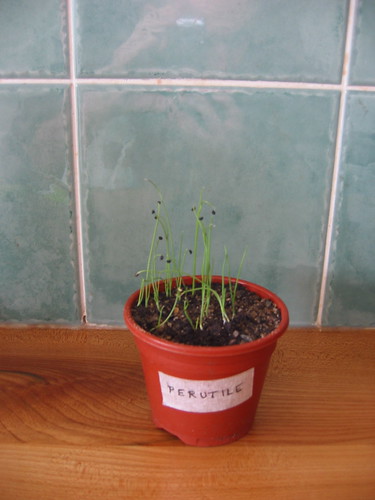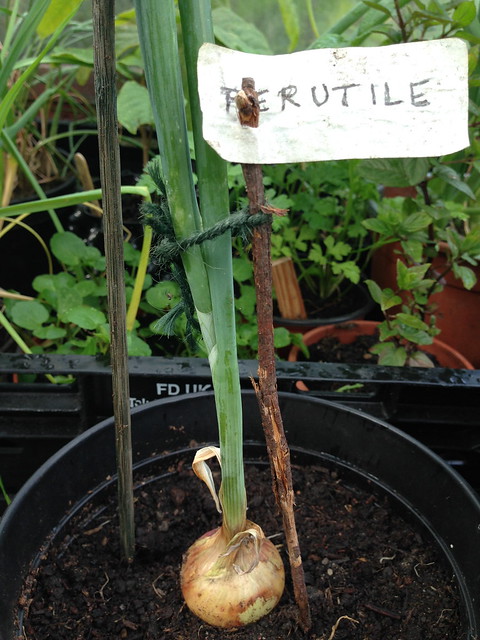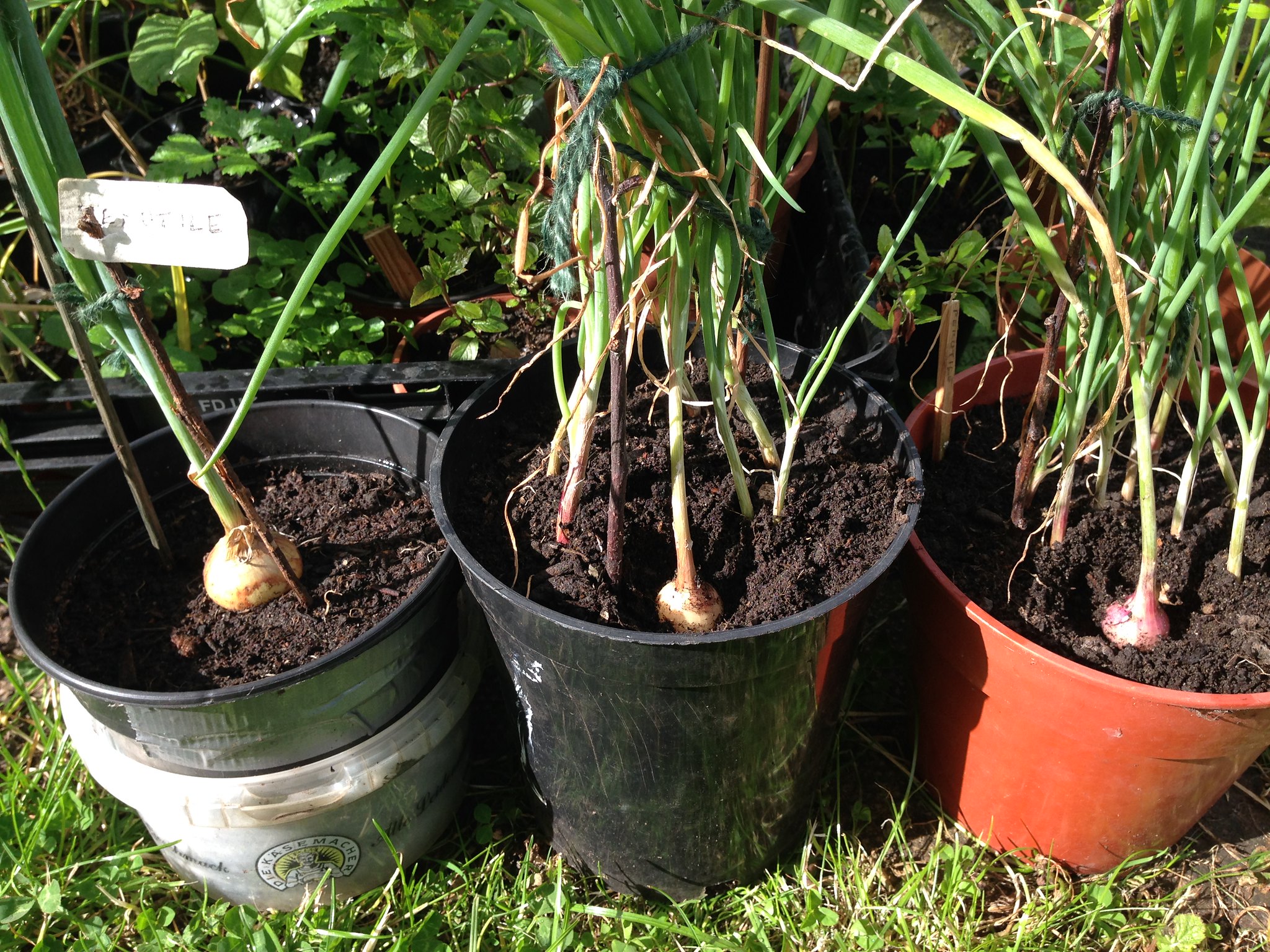|
|
Post by blueadzuki on Aug 31, 2014 7:29:36 GMT -5
The "L." stands for Linneaus. In scientific names it is common to follow them with a abbreviation the name of who actually give it the name. Linneaus was the first namer (and the one who named the most) so they can get away with a single letter initial.
|
|
|
|
Post by templeton on Aug 31, 2014 19:25:40 GMT -5
As I understand it the species; Allium Cepa L. (not sure what the "L" signifies), is comprised of three horticultural groups. The Cepa group. Only one form is represented in this group- A. cepa var. cepa. The Aggregatum Group. Which includes the cultivars; shallot, potato onion & ever-ready / perutile onion. E.g. Allium cepa L. (Aggregatum Group) cv. 'Perutile' The Proliferum Group. Topset onions. But Allium fistulosum can cross with Allium cepa & I think Topset onions are now regarded as such a hybrid. Allium fistulosum comprises Welsch Onions & numerous mainly oriental cultivars. I have Red Welsch Onions (they ain't Welsh so Welsch denotes the Old Germanic root word meaning foreign), & Kaigaro bunching onions growing next to Perutile onions. The main difference is the Welsch Onions flower & have more tubular leaves. Perutile Onions are very vigorous & divide profusely. I must have a hybrid. Mine are extraordinarily tough in the horticultural sense. I've had bunches survive being dug up and dried for weeks then replanted, bunches survive in unwatered pots for months over summer, staying green, and surviving my admittedly light frosts without ill effect. However, they never form basal bulbs, never die right down, and always form topsets. They rarely flower - amongst the topset bulbils, and only with extreme de-bulbiling have they ever set seed - 3 seeds, actually, of which one germinated. T |
|
|
|
Post by raymondo on Sept 1, 2014 1:29:19 GMT -5
templeton, the L. is for Linnaeus who is thus credited with having named it. In a herbarium collection, the label would always include the namer: for example Cucumis queenslandicus I.Telford is a native cucumber named by Ian Telford. Only Linnaeus is abbreviated to a single letter. Edit: Oops..I didn't see your post blueadzuki. Apologies for doubling up.
|
|
|
|
Post by Al on Sept 1, 2014 4:26:54 GMT -5
Tempelton
Extreme de-bulbiling! Sounds like something you need specialist insurance cover for like bungee jumping or white water rafting!
Just to be clear, when I say my Perutile Onions (if that is what they are) never flower. I mean they do not even send up any kind of reproductive stalk (scape?) with flowers or bulbils.
If an cepa x fistulosum cross tends to produce a top setting onion with some basal bulb development like Egyptian Onions, maybe a cepa cv. perutile x fistulosum cross would produce a top setting onion with clusters at the base but little basal bulb development? Your onions sound like they have these characteristics. When you say yours do not bulb at the base, do they not even swell a bit as you can see in pictures of my strain? I find 4 or 5 of my onions have enough bulb to stand-in for a normal bulb onion. They are easy to peel, & are plentiful esp. in Spring when the stored onions are sometimes sprouting or eaten. And you have year-round salad onions.
Another thought, given that I heard of another grower who had a flowering perutile & has found that clump now flowers every year, might your strain just be descended from a flowering / bulbiling type. Where-as mine is a non-flowering sport. Also, where do I'itoi fit into this family tree?
I agree about the toughness of these things. Uprooted plants with no roots will lie around for ages, but still keep a little bit of green leaf. Very small offsets will effectively form long slender bulbs, all the green leaf drying back. Yet, as soon as they touch moist earth roots thrust out. The other thing that has impressed me is that they seem to be completely unaffected by white rot, rust, & insect attack.
I would like to increase the size of my bulbs so am experimenting with timing of planting & size of offsets planted. If you cut through a bulb there are clearly embryonic cloves ready to develop, fewer in number in small bulbs. So, in the same way that exhibition shallot growers aim to have clusters of only 3 or 4 to yield bigger bulbs, I have planted smallish plants from the best clumps, also will try separating clumps to individual plants at different times & will follow some of the top shallot growers methods. I would like to be able to grow from seed to try & select improved types but not sure if my flower will produce any viable seeds yet.
|
|
|
|
Post by kazedwards on Sept 2, 2014 0:21:03 GMT -5
Sounds like quite a project.
|
|
|
|
Post by robertb on Feb 6, 2015 14:30:19 GMT -5
Ive just been sent a perutile seed head as a surprise extra in a plant swap parcel. Someone told me it flowers whe stressed 'about as often as daubentons kale'. Ill grow the seeds on and see if if the offspring flower.
|
|
|
|
Post by Al on Feb 26, 2015 6:22:11 GMT -5
My everlasting onions which I tentatively identify as Perutile onions produced one flower last year. Possibly it does flower about as frequently as Daubenton's Kale. I sowed the seed in January & quite a few seedlings are now growing under lights, probably only about 50 percent germination but plants are looking healthy enough.  IMG_1324 IMG_1324 by portobell0, on Flickr |
|
|
|
Post by robertb on May 6, 2015 13:46:38 GMT -5
I planted my everlasting onion seed over a month ago, and noticed the first one germinating today. Better late than never!
|
|
|
|
Post by Al on Jun 4, 2015 8:40:50 GMT -5
Here's an update on the onion seedlings from my "non-flowering" Perutile? sowing in January; they are forming little onion plants, unsurprisingly. My row of Autumn planted Perutile have developed into sturdy plants (probably the biggest I have ever grown), & have mostly divided into clumps of 3, there is a useful white shank & a modest bulb. These formed from medium & small transplants. The row of 3 year old plants is getting overcrowded with plants reaching a much greater height, still providing lots of useful onions but there are an increasing number of tiddlers in the clumps. A couple of Spring planted onions are flowering, I don't think these were clones of my single flowering plant from last year so it might be a cultural factor that triggered the flowering? Stress during March perhaps? I have heard that shallot bolting can be caused by checks to growth by dryness, cold snaps etc.. The last picture below shows the Autumn planted row centre, older rows on the right, & Kaigaro (Allium fistulosum) on the left flowering vigorously. flic.kr/p/tQc52Q flic.kr/p/tQc5kf flic.kr/p/u7WS8t flic.kr/p/tQc64j |
|
|
|
Post by Stump on Jul 18, 2015 0:22:57 GMT -5
I noticed this morning that I have 5 flower heads coming up from one bunch of clones. Will be interesting to see if others form on my Purutile sourced from elsewhere.
|
|
|
|
Post by robertb on Jul 23, 2015 4:33:59 GMT -5
I've got one plant from the Perutile seed I planted last spring. I've got more in the freezer for next year. It's going to be nteresting to see whether this generation will be any more willing to flower of produce viable seed!
|
|
|
|
Post by Al on Jul 25, 2015 4:42:46 GMT -5
 IMG_1505 IMG_1505 by Alex Taylor, on Flickr  IMG_1506 IMG_1506 by Alex Taylor, on Flickr Well I certainly was not expecting Perutile seedlings to develop individual bulbs. These onions are quite different from the parent plant, the parent grows in clumps & only develops a slight swelling at the bottom of the shank. These seedlings have proper bulbs with distinct shoulders, real little globes.They appear to be rosy pink on the outside, although there is a bit of variation with some of them more yellow in colour. I remember reading that Kelly Winterton had large single bulbs from his first sowing of Green Mountain seed. Thereafter the re-planted bulbs divided, so I wonder if my Perutile bulbs will divide in future? Or were my original plants just some hybrid, perhaps a fistulosum X cepa cross? So the offspring are just reverting to one or other of the parental types. I have 4 or 5 flowers this year in my original "non-flowering" rows of Perutile onion so hope for some more seed, & I will be interested to see what these little bulbs do if planted next Spring. Though the parent is evergreen so I don't know if these babies will need to be lifted & stored, or if they will just try to keep growing through the Winter. |
|
|
|
Post by templeton on Jul 25, 2015 23:28:35 GMT -5
interesting. keep us up to date.
T
|
|
|
|
Post by Stump on Jul 26, 2015 1:56:26 GMT -5
If they act like potato onions they will divide in their second year. I remember reading articles by Kelly Winterton where he said onions are bi annual
|
|
|
|
Post by philagardener on Jul 26, 2015 20:07:44 GMT -5
Growing from Kelly's seeds, I got small bulbs the first year. Replanted, some formed small nests (2-3 bulbs) in the second year whereas a few went on to flower without dividing. There is lot of diversity that gets unlocked when these things finally flower and set seed.
|
|